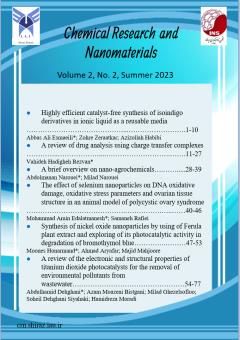-
-
List of Articles
-
Open Access Article
1 - Highly efficient catalyst-free synthesis of isoindigo derivatives in ionic liquid as a reusable media
Abbas Ali Esmaeili Zohre Zeraatkar Azizollah Habibi -
Open Access Article
2 - A review of drug analysis using charge transfer complexes
Vahideh Hadigheh Rezvan -
Open Access Article
3 - A brief overview on nano-agrochemicals
Abdolmanan Narouei Milad Narouei -
Open Access Article
4 - The effect of selenium nanoparticles on DNA oxidative damage, oxidative stress parameters and ovarian tissue structure in an animal model of polycystic ovary syndrome
Mohammad Amin Edalatmanesh Samaneh Rafiei -
Open Access Article
5 - Optimization of gel formulation containing CMC, HPMC, and PVA enhanced cosmetic, hygiene, and pharmaceutical applications using central composite design (CCD)
Rezvan Ahmadi pour Farzaneh Ebrahimzadeh -
Open Access Article
6 - A review of the electronic and structural properties of titanium dioxide photocatalysts for the removal of environmental pollutants from wastewater
Abdulhamid Dehghani Azam Moazeni Bistgani Milad Ghezelsofloo Soheil Dehghani Siyahaki Hamidreza Moradi
-
The rights to this website are owned by the Raimag Press Management System.
Copyright © 2021-2025







